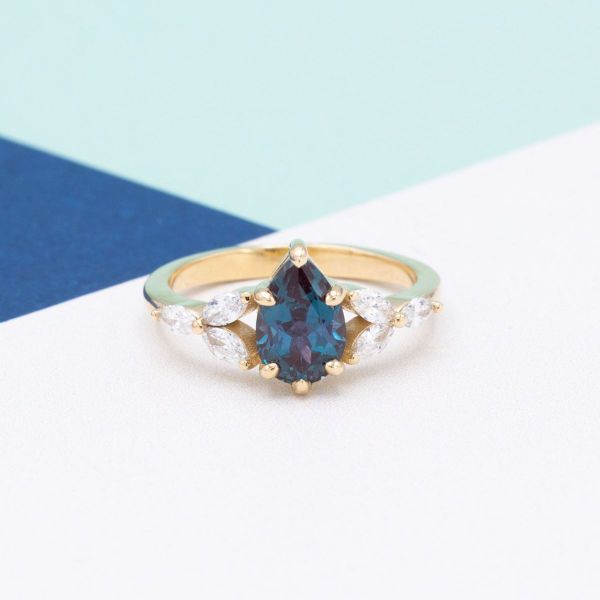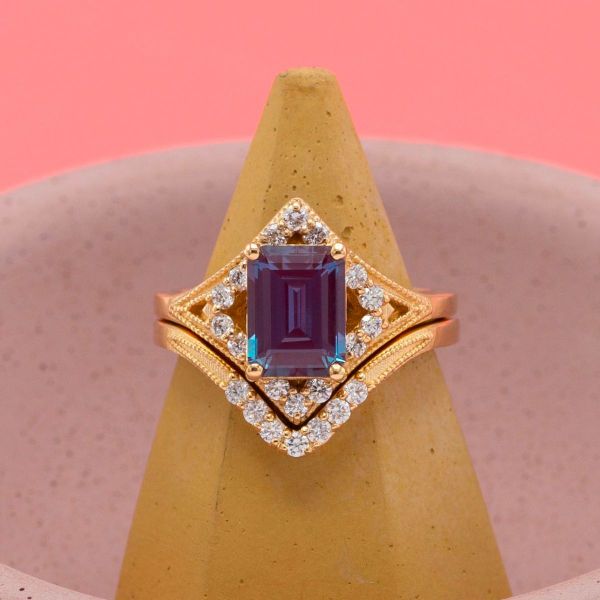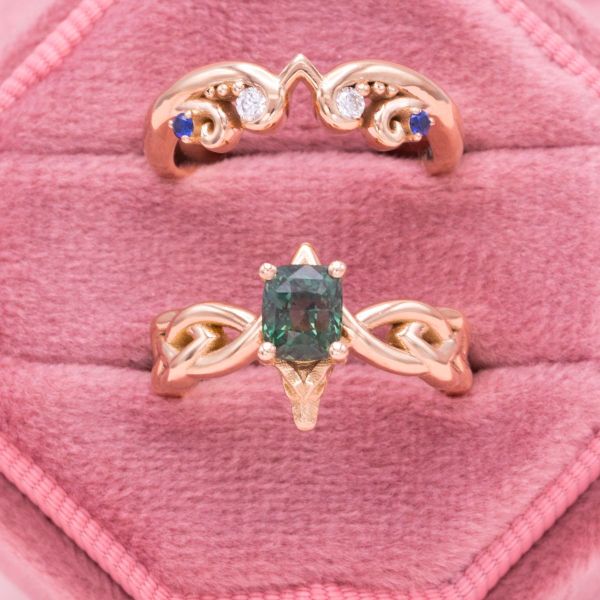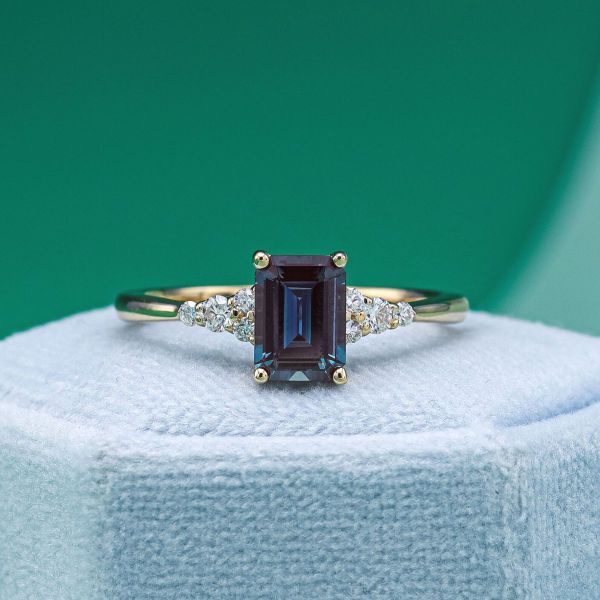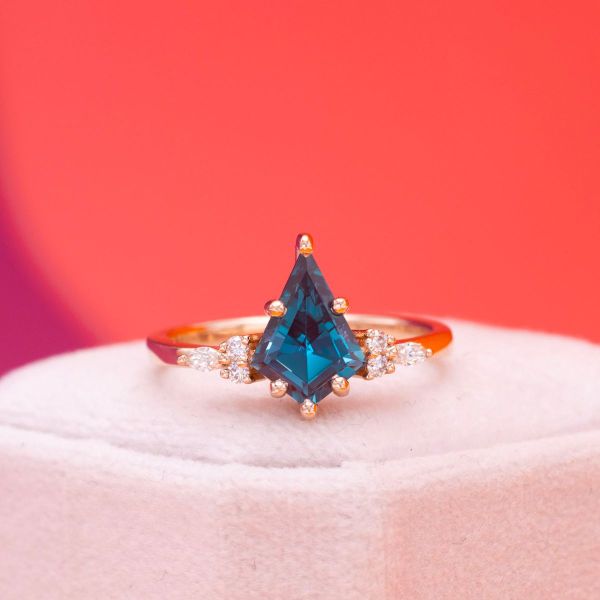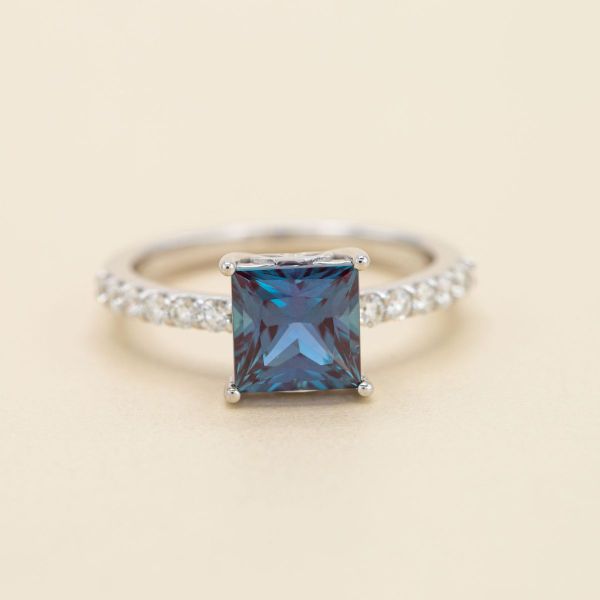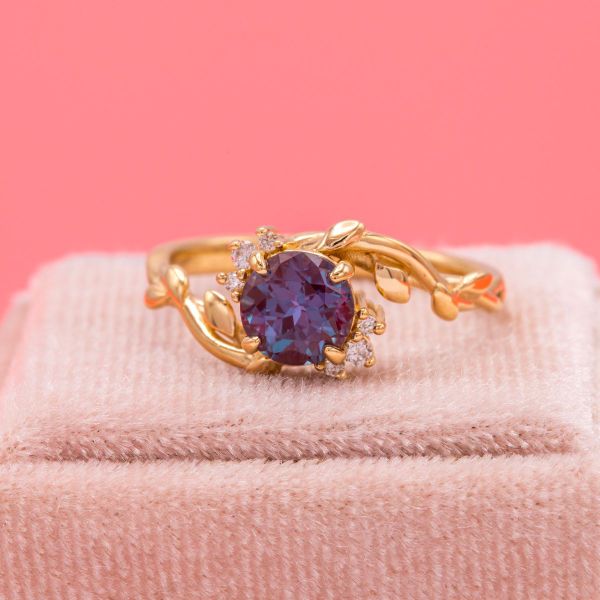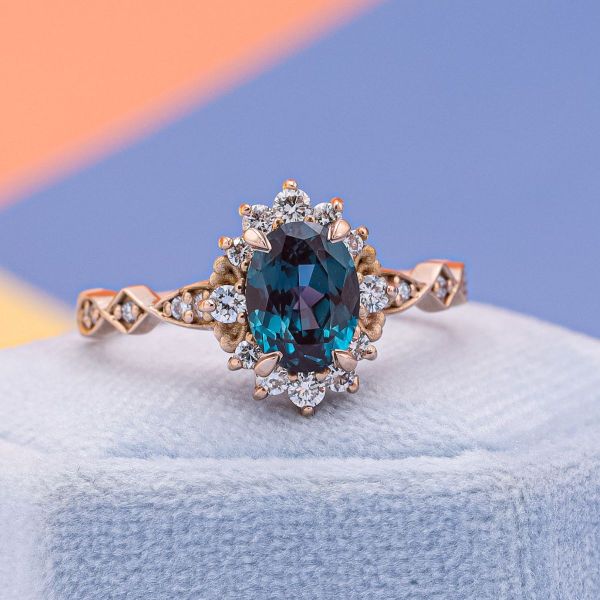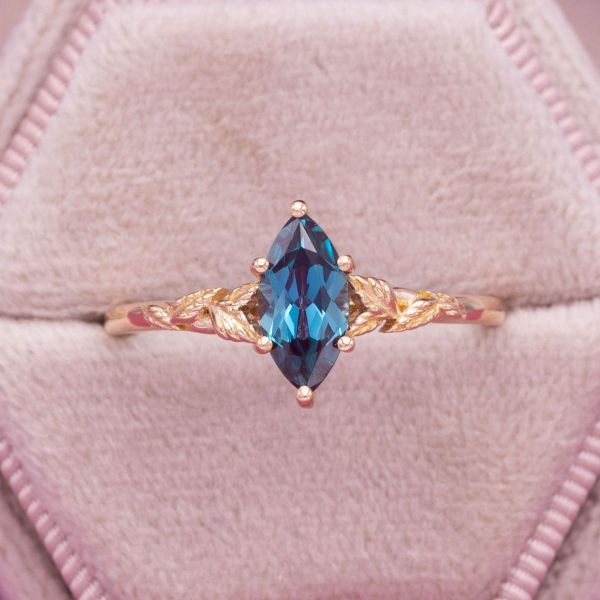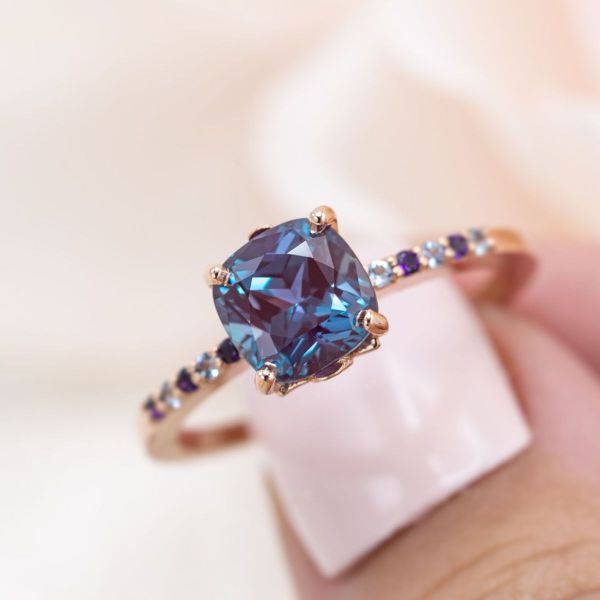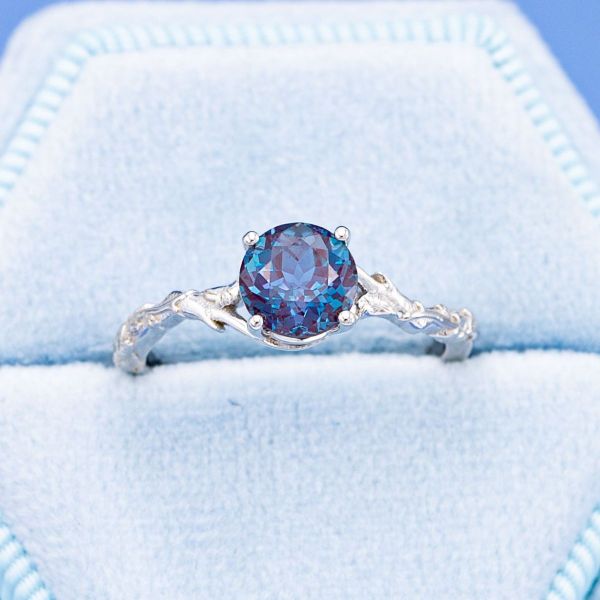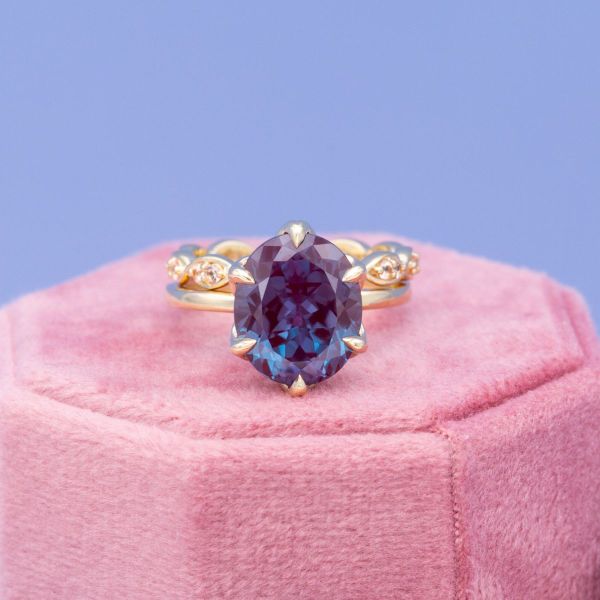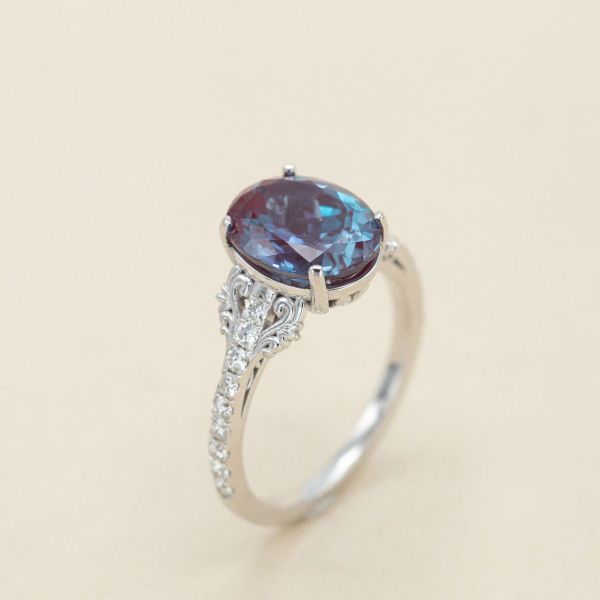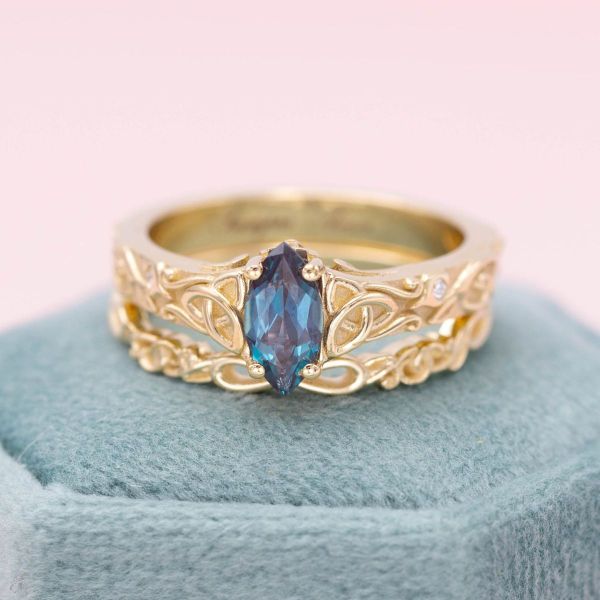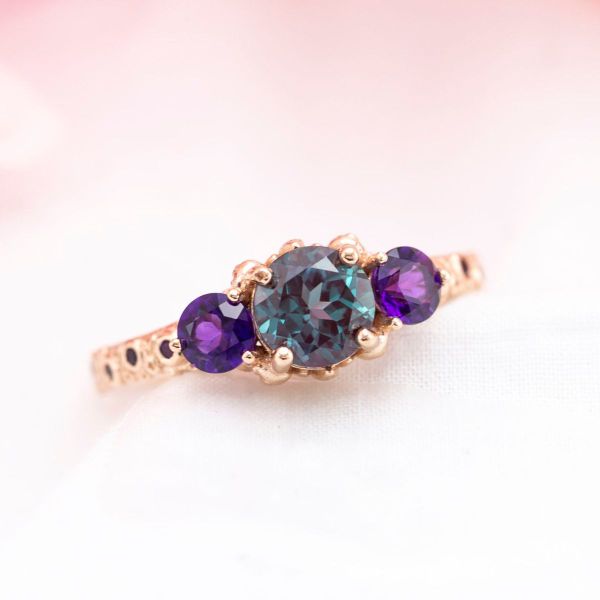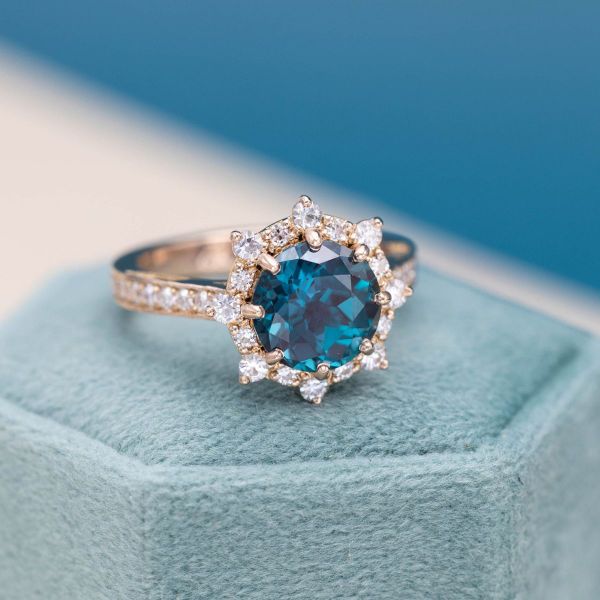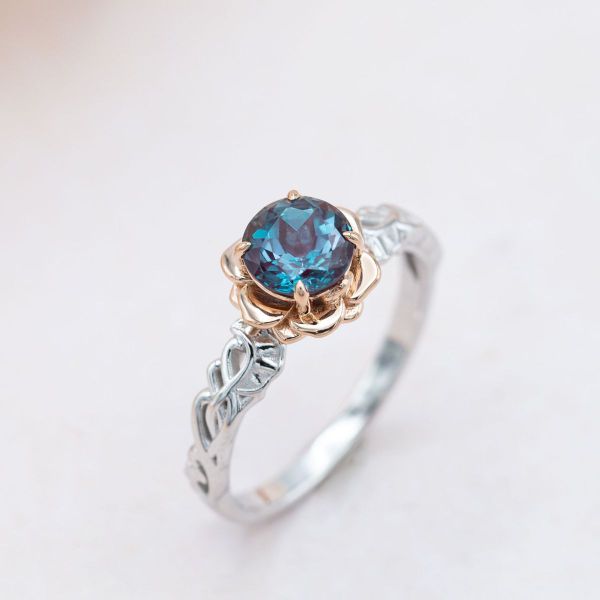Gemstone Knowledge
How to pick the perfect alexandrite
A guide to choosing the right color, cut, and clarity for your alexandrite engagement ring
Choosing an alexandrite for your engagement ring
So you’ve fallen under the spell of the mesmerizing alexandrite—the stone that appears to change color before your very eyes! Alexandrite is a stunning addition to any engagement ring, but how can you find a quality stone when no two alexandrites look exactly alike? And besides the obvious differences like color and color change, are there other things you should look for when picking an alexandrite?
Colored gemstones may not follow the 4Cs quite like diamonds do, but there are still several details to consider when choosing the right alexandrite for your taste. Let’s take a closer look at some factors to keep in mind when shopping for your ideal stone.
Color shift
If you’ve chosen an alexandrite for your engagement ring, you may be seeking that magical color change you’ve heard so much about. It’s true, some alexandrites appear to change color right in front of you! But, in reality, it’s the lighting in your environment that causes this apparent shift. In daylight and fluorescent lighting, alexandrite takes on cooler tones like green, blue, and teal. However, under dim or incandescent lighting, you’ll typically notice hues like brown, purple, red, and even purple-red.
Just know that not all alexandrites offer an intense color change, and transitions are a percentage rather than a simple “yes” or “no”. For instance, high—quality alexandrite may experience an 85% to 95% color shift, but stones in general can sit anywhere between a 5% and 100% change. So, a noticeable color change isn’t a sure thing, but that doesn’t mean alexandrites that display weaker transitions are any less lovely! Plus, if you have your heart set on a color shifting stone, lab alexandrites offer a more standardized color transition since they’re made in a controlled environment.
Alexandrite is often called an “emerald by day, ruby by night”, but these are just the hues associated with a classic, natural alexandrite. The list of alexandrite’s possible colors might surprise you: spring green, purple-red, blue, teal, lavender, brown, deep red, forest green, pink, peacock blue, pomegranate—these are just some of the hues you may encounter. What’s more, these colors can come in various combinations, with transitions that include green to pink, blue to purple, teal to purple-red, green to light purple—you get the idea!
Hues may also vary depending on where the stone is from. Russian alexandrites have a classic green to red coloration, whereas stones from India are often green-blue in color. There are also Brazilian alexandrites with blue-green hues that transition to raspberry red in dimmer lighting, and Tanzanian stones have a green to reddish purple shift. And let’s not forget lab alexandrites, which have a stunning blue, purple, or teal color in daylight and transition to red or purple in low lighting! So you never know what you’re getting unless you inspect each stone for yourself under different light sources, and that’s exactly what we recommend you do to make sure you find the right hue and color combination for your ideal setting.
Another facet of color to keep in mind is saturation, which is closely tied to deeper colors like purple-red and forest green. Moderately strong to strong saturation leads to these richer shades, but you may love the sweet pastel colors of alexandrites with lighter saturation, like light purple, spring green, and light pink shades. Tone is another factor that impacts the intensity of alexandrite’s color change, and stones with darker tones in the 75% to 85% range offer the best backdrop for a high-quality color transition. Most alexandrites have tones in the 40% to 60% range–so their color change won’t be quite as dramatic–which gives you an idea of just how rare that complete color transition really is!
Shape and cut
You’ve probably heard us mention that “cut is king” when it comes to diamonds. That’s because a diamond’s cut is crucial to proper light performance: you need all of those nicely cut facets for light to enter and bounce around the stone to produce maximum fire, brilliance, and scintillation. Cut may be one of the top factors for a high-quality diamond, but it's not the only thing that matters with alexandrite, so you can have a bit more fun with picking different shapes and cuts! There isn’t necessarily an ideal cut or shape for alexandrites like there is for diamonds, and at most your choice may affect the hues you notice within your stone, particularly with those pleochroic displays.
Because alexandrite’s color transitions relate to light rather than shape, alexandrite really looks wonderful in any silhouette. Round brilliants are a popular option for balancing sparkle and color, but alexandrite looks exquisite in fancy cuts as well. A brilliant cut alexandrite like a marquise, oval, princess, or cushion can amp up the color display as you move it around for eye-catching hints of changing color that’ll make it hard to focus on anything other than your ring (but do you really want to focus on anything else?). Step cut shapes are better for showing off your alexandrite’s color, primarily in the corners and facets of each stone.
For pleochroic color shifts, more facets will bring you more hints of those orange, purple, and blue hues as you move the stone around. Pleochroism requires angled surfaces for light to enter and exit the stone, so shapes with more facets provide plenty of angles for subtle hints of color as you move your alexandrite back and forth.
And let’s not forget cabochon alexandrite! If that’s one you haven’t heard before, a “cabochon” is a rounded, polished stone with no faceting. There are rare alexandrites that have a gorgeous “cat’s eye” effect, where a line appears to run down the center of the stone like a cat’s pupil. These stones typically come in cabochon cuts and can exhibit color change, offering a unique take on traditionally sparkly alexandrite.
Clarity
Admittedly, this topic will matter to some couples more than others, and we’ll explain why below. As a Type II stone, alexandrite isn’t typically eye clean, but this shouldn’t stop you from falling in love with its striking variety of shades and unique color shift!
The GIA divides gemstones into three "clarity types" to describe what type of inclusions you may find in a stone and how many may form. Alexandrite is a "Type II", which means it usually has visible inclusions.
Clarity really comes down to what you’re looking for in an alexandrite. If you want a stone with lighter hues and aren’t concerned with shifting colors, focusing a little more on clarity may be a good idea just to ensure you find an eye-clean stone. But, if you’re more focused on color change, you may need to accept a few inclusions to get an intense transition. Some inclusions–like rutile–are even thought to enhance this color shift, which means you’ll get a more noticeable transition simply because your stone has a few bonus minerals.
Once again, lab alexandrites are more uniform thanks to their controlled lab environment, so they feature fewer inclusions if that’s something you’re concerned about. Either way, our team can walk you through various types and shades of alexandrite to help you find the right one for your engagement ring!
Other factors to consider
Price
If you’re looking for a natural alexandrite, you’ll want to factor price into your decision. Natural alexandrite is incredibly rare, which means it’s pricey enough to make or break a budget. For just a 1 carat mined alexandrite, prices can exceed $4,000 and go all the way up to $70,000! And if you want that classic green to red color change, expect prices at the higher end of this range.
On the other hand, lab made alexandrite is rather affordable, ringing in at around $525-550 for a stone of the same size and quality as our example above. Plus, lab alexandrites offer vivid blue, purple, and red hues and noticeable color change, so you can find a stone with similar appeal to a natural alexandrite fairly easily. It all just comes down to your needs and budget.
Size
High-quality natural alexandrites are rare, and they're even rarer in sizes over 1 carat that make for good center stones. It takes some expert hunting to find the right one, but when you do–you know you've found a real gem (get it?!). Natural alexandrites can technically be found all the way up to 10 carats, but those come with a hefty cost with larger stones often exhibiting a weaker color change. Lab alexandrites can be a great alternative for some couples, offering a range of sizes with vibrant colors and noticeable transitions. And with the lab stone’s stable pricing structure, you may be able to get more alexandrite than you originally anticipated!
Setting
Because alexandrite exhibits some level of color shift, it really can fit any setting. From sunny metals like yellow and rose gold to icy options such as white gold and platinum, alexandrite’s chameleon-like qualities make it a great fit for most settings. White diamonds and moissanites are perfect accents for alexandrite, as they offer a neutral palette for its color transitions and pleochroism. A few clusters of diamond accents or a bright diamond halo are ideal ways to show off your alexandrite’s unique appeal, but your stone will also look just as amazing in a solitaire setting. Alexandrite is also a wonderful complement to other colored gemstones, looking dazzling in two and three stone settings as well.
Review individual stones
As you can see, there’s a lot to consider when choosing the right alexandrite for your engagement ring! The best thing you can do for yourself during the process is make sure you review stones with high resolution images and videos for the most accurate look at each one’s color and qualities. Other than that, what really matters is that you love the stone you choose. Much like finding your perfect partner in life, choosing the “right” alexandrite comes down to which stone has the best qualities for your taste. So click here to contact our team and start your journey toward your dream engagement ring!
About CustomMade
CustomMade designs and creates one-of-a-kind, custom engagement rings and fine jewelry. Each piece we create is inspired by you, designed for you, and made just for you.
